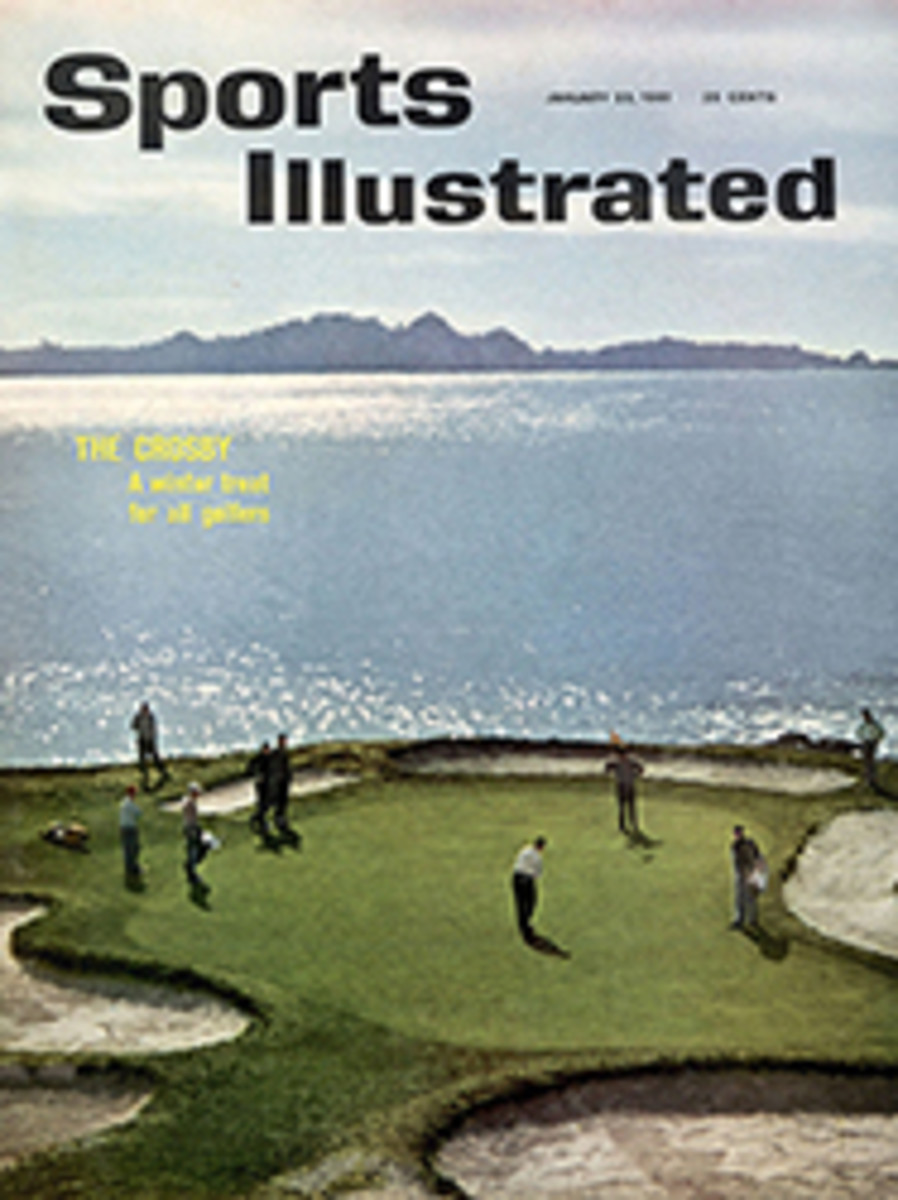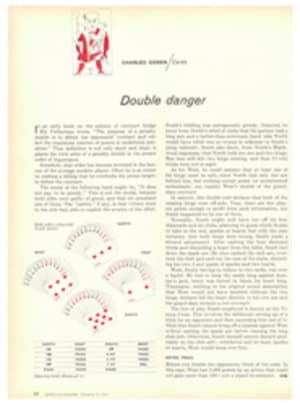
DEBACLE IN THE DESERT
For 364 somnolent days a year the Lucerne Valley, a floor of the high desert some 35 miles from Victorville, Calif., is a happy hunting ground of rattlesnakes, desert rats, rabbits and road runners. But on the 365th, civilization (if that's the word for it) comes to the Lucerne Valley in the form of about 800 motorcyclists who congregate by truck, jeep, trailer and auto for the world's largest motorized sporting event—the so-called "Big Bear Run."
The name derives from the fact that in the past 39 years of its existence, this cross-country motorbike dash ran from the town of Lucerne to a place called Big Bear. But this year the California Highway Patrol set its foot down—hard. The cyclists were restricted to their own marked-out area of the desert, a 152-mile cloverleaf in the sage and scrub spreading from the valley's basin up the side of surrounding truncated hills and back down again—three loops in all, with two screaming runs through the stem of the leaf.
The cyclists would be restricted in other ways, too, the legitimate operators in this lively business hoped. These worthy people have been busy for the past few years trying to erase a well-established public image of the sport as a haven for sideburned delinquents. Some have gone so far as to ask manufacturers not to make accessories like the gallows-high handle bars, known to cyclists as "ape hangers," which serve no purpose other than to identify the owner as a bonafide wild one, ready for a jug of wine, a small-town raid or a fast game of chicken. The big, bulky machines of the hoodlums' Panzer divisions, furthermore, were not permitted to enter at Big Bear. In their place were sporty little racers not even licensed for highway travel. They were expensive enough to encourage a confident feeling that they would be out of the financial reach of cycling's undesirable element.
Alas for such illusions! As the whole gaudy panoply—trailers with flame-striped sides, pickup trucks with tarpaulined cycles on the back and sputtering little sports cars hauling their machines on trailer beds—rendezvoused on the floor of the desert in the pre-dawn, below-freezing hours last week, it was evident that not all the cyclists were the responsible capitalists the sponsoring Orange County Motorcycle Club had hoped for. In fact, some of them looked suspiciously like the apes the American Motorcycle Association would like to hang on its own bars.
There were bearded tough guys in top hats and young swaggerers in black leather jackets with "Hell's Angels—Berdoo" painted on the back. There were Brandoesque groups standing around a wood fire passing a gallon jug of wine and mustachioed thugs with pints of applejack stuck in their boots. In short, enough certified kooks to show that the romance had not gone out of California motorcycling altogether.
On the other hand, there were the respectable motorcycle clubs like the California Gophers and The Checkers and the quasi-factory teams clustered around the Triumph, Honda, Matchless and Yamaha pits. There were also entrants from .Britain and Australia, and even the Japanese champion. Presumably, these guest riders thought they were at an American sporting event like the World Series or Indianapolis.
The start of the Big Bear is always an 800-cycle rodeo, a wild, screaming scramble across a starting line that is haphazardly marked out through the sagebrush. Right up to lineup time roving cyclists seek out information from officials on "which side is best to line up on—where's the course?" The course, however, is kept secret and is marked out by sacks of lime only a few hours before the start.
The race is meant to start at 9:30 a.m. sharp, when a banner is flashed from an officials' truck posted some 150 yards in front of the starting line. After the lineup, contestants are expected to cut their engines and not to fire them up again until they sight a smoke bomb on the horizon five minutes before take-off. Finally, they are not supposed to take off until the flag falls.
The noise before the storm
At 9:17 a.m. on this year's race day, long queues of late arrivals were still waiting to put down entry money at the officials' ticket window. A score or more drivers were out swirling around in front of the finish line, testing the terrain. No one had yet cut his engine. A representative of the largest motorcycle distributor in California was strolling along with a sportswriter in front of the starting line, proudly explaining, "We have come a long way in motorcycling. These boys are true sportsmen in every sense of the word and this is an event which will grow...."
At precisely that instant his words were drowned by a sudden terrifying increase in the pitch of the warming engines. He and his companion threw a horrified look to their left—to see an unstoppable scramble of pell-mell motorcycles bearing down on them. Wild-eyed riders were pouring on the coal. In undignified rout the official and his friend dashed for safety.
The premature starters demoralized the whole line. Others started, came back, panicked and started off again in wild pursuit. Out on the course the startled pilots testing the terrain turned tail and ran out ahead of the pack. Dismayed officials stood wringing their hands. "Call them back! You've got to call them back!" screamed the starting truck. "How?" asked the starting marker succinctly. It was a good question. But the worst was yet to come.
In the Big Bear Run, to eliminate cheating, machines are given a secret crayon mark on the fuselage at the start and at each of the secret check points on the course. When the first bikes streamed into the first check points sans starters' checks, the checkers there silently and without explanation scrawled a huge crayoned "X" on each fuselage. The drivers paid little attention, but the pit crews spotted the cryptic mark and when later drivers pulled into the pits without X's (the absence of which, as it happens, signified that they were legitimate contestants), the crewmen promptly scrawled X's on those fuselages to help the drivers out. It was the worst disservice they could have performed, and it turned the race into a debacle.
The riders—late and early starters—found the course only with great difficulty, and some resorted to a desperate game of follow-the-leader. Frequently this turned the game into an 80-mile-an-hour blindman's buff. Natural hazards were unforeseeable, and from time to time the carnage made it appear someone had thrown a hand grenade in the midst of the pack. By midrace the toll read: two broken arms, one broken back, five dislocated shoulders, two multiple rib fractures and a plethora of minor leg injuries.
It became clear that no driver could be declared winner. Those who weren't wounded were insisting that they had waited patiently at the starting line for as much as 20 minutes after the rolling start and no starting checker came near them. Legitimate starters had telltale X's, thanks to their well-meaning friends. Claims and counterclaims would have raged until well into the summer. The sponsoring Orange County Motorcycle Club did the only thing it could do. It ruled the 1961 Big Bear Run "no contest," and motorcycling, no matter what its good intentions, had once again given itself a hard boot in its black denim trousers.
PHOTO
JUMPING FLAG, MOTORCYCLISTS ROAR OFF ACROSS DESERT IN A SWIRL OF DUST AS OTHERS NERVOUSLY AWAIT STARTER'S SIGNAL
PHOTO
OIL CAN IN HAND, PITMAN SCURRIES OUT OF PATH OF INCOMING RACER

